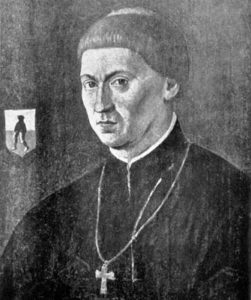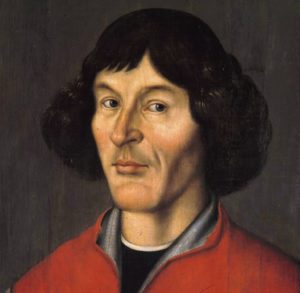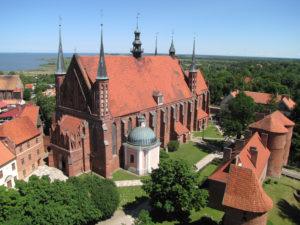The man who ‘stopped the sun, moved the earth’ was not only an astronomer, but also an economist, lawyer, translator, doctor, mathematician and cartographer. He is known primarily as a creator of the heliocentric system theory, a breakthrough in science and a radical shift of the world view of that time.
by Piotr Bejrowski
Nicolaus Copernicus was born on 19 February 1473 in Toruń, which was within the borders of the Kingdom of Poland under the Treaty of Toruń in 1466 (ending the Thirteen Years’ War against the Teutonic Order). Copernicus grew up among the German-speaking wealthy middle class, supporting the incorporation of the so-called Royal Prussia to the Crown. After the death of his father, his mother’s brother, Łukasz Watzenrode, a thoroughly educated man, and the future Bishop of Warmia, took care of him. It was thanks to his protection that Copernicus began studying mathematics and science at the Krakow Academy (1491-1495), and later studied law in Bologna (1496-1501) and medical studies in Padua (1501-1503), which he combined with obtaining a doctorate in canon law from the University of Ferrara (1503).

In Krakow, Copernicus received his first exposure to the critical approach to the geocentric concept and learned to use astronomical instruments and tables. While in Italy, he had already conducted independent observations and further explored the Ptolemaic models that dominated 16th Century science. After returning to the Polish-Lithuanian state, he spent forty years of his life mainly in the Northern Warmia region, where he first worked in Lidzbark Warmiński as a secretary and physician of the bishop. After his uncle’s death he served as a canon (but without ordination) at the cathedral in Frombork, where he also conducted most of his observations. He died and was buried in Frombork on 24 May 1543.
Copernicus developed his heliocentric theory, hypothesizing the Earth’s revolution around the Sun, between 1515-1530. His theory refuted the geocentric vision of the system according to Ptolemy of Alexandria that had been the only accepted explanation for centuries. His groundbreaking treatise De revolutionibus orbium coelestium was finally published in 1543 in Nuremberg. Copernicus and his theory had long been the object of criticism and mockery, including from Martin Luther. Despite the fact that in the 17th Century, mainly thanks to the work of Galileo and Johannes Kepler, the theory had grown in importance and was the basis for one of the most important scientific revolutions in history (the so-called Copernican Revolution), the Catholic Church placed the work on its index of forbidden books. Experiments proving the validity of the theory were carried out only in the following centuries.

He was a real polymath, and, apart from observing the sky, Copernicus was active in other areas too. In 1522 he published a treatise On the Value of Coin, in which he presented the rule, known today as the Gresham-Copernicus law, which says that good money will be driven away by bad money. He also postulated the monetary unification of the Crown and Prussia, while pointing out methods of securing money against devaluation. In addition to monetary policy, Copernicus was very busy as the governor of the Warmian bishopric. He went with a diplomatic mission to the Grand Master of the Teutonic Order, reinforced the castle in Olsztyn, participated in conventions with Royal Prussia, attended parliament (Sejm) in Kraków and took part in negotiations with the Teutonic Knights regarding the return of the city of Braniewo.
Karol Górski, an outstanding historian and biographer of Copernicus, emphasises that the genius astronomer happened to live during the reign of Sigismund the Old and in the ‘golden age’ of Polish history – a time of exceptional peace (interrupted by a short ‘Prussian war’ against the Teutonic Order, 1519-1521), and an economic and cultural blossoming. The state provided him with the necessary conditions, while the social environment from which he came had a significant impact on shaping his views and personality. Copernicus himself believed that it was thanks to the patrician of Toruń that he had learnt such qualities as: diligence, duty, commitment to liberty and privileges, loyalty to the king and dynasty chosen to rule Prussia by its inhabitants, as well as an understanding and interest in economic matters. In Kraków he began to doubt the system created by Ptolemy, and in Italy he came across ancient authors and conducted further research. He probably brought home the new idea of the Solar System at this time.

When Copernicus left Lidzbark Warmiński and moved to Frombork, he consciously gave up his political and spiritual career in favour of an idea that he intended to develop. He also chose scientific loneliness, because the chapter’s community did not provide him with intellectual support. Copernicus finished working on his magnum opus in his older years, supported by the only student, the astronomer Georg Joachim von Lauchen, known as Retyk (1514-1574), thanks to whose efforts the work was published in Germany. Soon after, it would change the entire scientific world.
Author: Piotr Bejrowski
Translation: Alicja Rose & Jessica Sirotin





